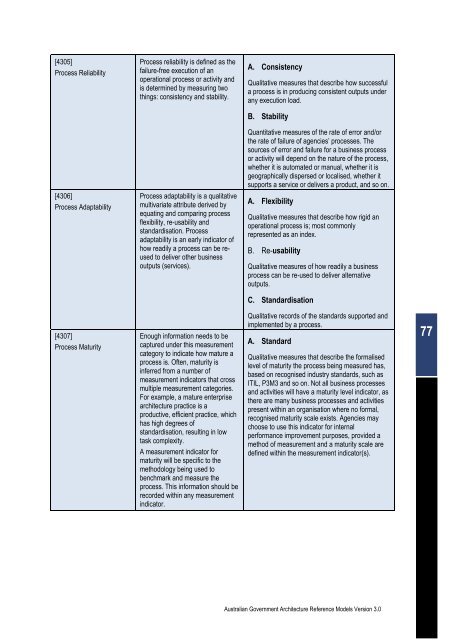Australian Government Architecture Reference Models Version 3.0
Australian Government Architecture Reference Models Version 3.0
Australian Government Architecture Reference Models Version 3.0
Create successful ePaper yourself
Turn your PDF publications into a flip-book with our unique Google optimized e-Paper software.
[4305]<br />
Process Reliability<br />
[4306]<br />
Process Adaptability<br />
[4307]<br />
Process Maturity<br />
Process reliability is defined as the<br />
failure-free execution of an<br />
operational process or activity and<br />
is determined by measuring two<br />
things: consistency and stability.<br />
Process adaptability is a qualitative<br />
multivariate attribute derived by<br />
equating and comparing process<br />
flexibility, re-usability and<br />
standardisation. Process<br />
adaptability is an early indicator of<br />
how readily a process can be reused<br />
to deliver other business<br />
outputs (services).<br />
Enough information needs to be<br />
captured under this measurement<br />
category to indicate how mature a<br />
process is. Often, maturity is<br />
inferred from a number of<br />
measurement indicators that cross<br />
multiple measurement categories.<br />
For example, a mature enterprise<br />
architecture practice is a<br />
productive, efficient practice, which<br />
has high degrees of<br />
standardisation, resulting in low<br />
task complexity.<br />
A measurement indicator for<br />
maturity will be specific to the<br />
methodology being used to<br />
benchmark and measure the<br />
process. This information should be<br />
recorded within any measurement<br />
indicator.<br />
A. Consistency<br />
Qualitative measures that describe how successful<br />
a process is in producing consistent outputs under<br />
any execution load.<br />
B. Stability<br />
Quantitative measures of the rate of error and/or<br />
the rate of failure of agencies’ processes. The<br />
sources of error and failure for a business process<br />
or activity will depend on the nature of the process,<br />
whether it is automated or manual, whether it is<br />
geographically dispersed or localised, whether it<br />
supports a service or delivers a product, and so on.<br />
A. Flexibility<br />
Qualitative measures that describe how rigid an<br />
operational process is; most commonly<br />
represented as an index.<br />
B. Re-usability<br />
Qualitative measures of how readily a business<br />
process can be re-used to deliver alternative<br />
outputs.<br />
C. Standardisation<br />
Qualitative records of the standards supported and<br />
implemented by a process.<br />
A. Standard<br />
Qualitative measures that describe the formalised<br />
level of maturity the process being measured has,<br />
based on recognised industry standards, such as<br />
ITIL, P3M3 and so on. Not all business processes<br />
and activities will have a maturity level indicator, as<br />
there are many business processes and activities<br />
present within an organisation where no formal,<br />
recognised maturity scale exists. Agencies may<br />
choose to use this indicator for internal<br />
performance improvement purposes, provided a<br />
method of measurement and a maturity scale are<br />
defined within the measurement indicator(s).<br />
<strong>Australian</strong> <strong>Government</strong> <strong>Architecture</strong> <strong>Reference</strong> <strong>Models</strong> <strong>Version</strong> <strong>3.0</strong><br />
77

















